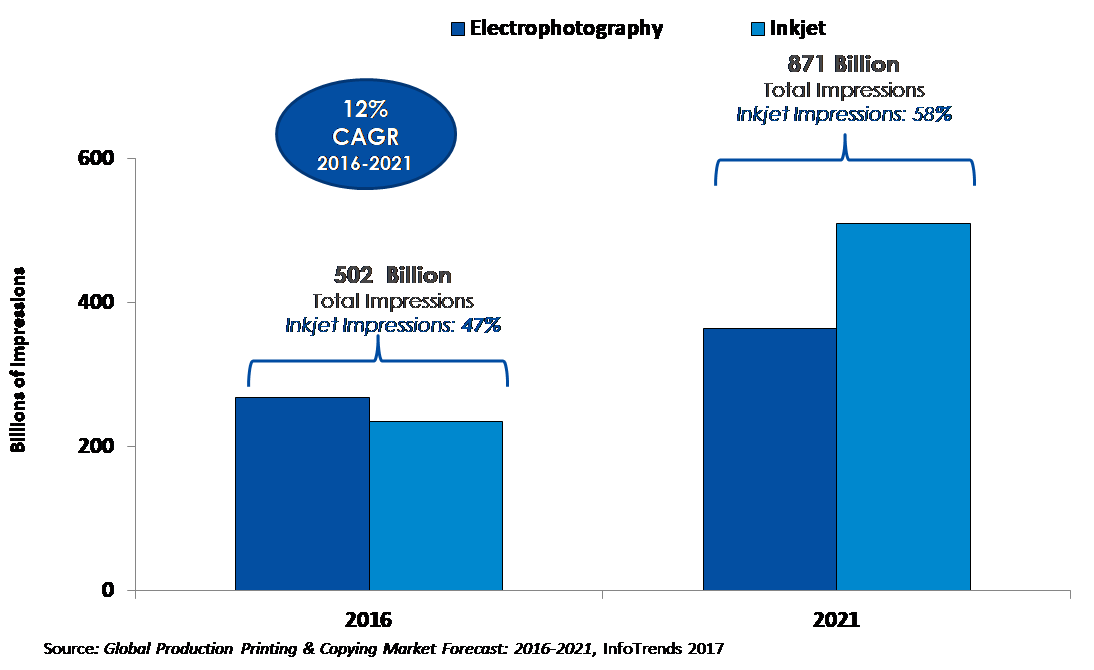This article originally appeared in the January/February, 2018 issue
of Mailing Systems Technology.
High-speed inkjet technology is transforming color printing and creating many opportunities for direct and transactional mail. Inkjet offers all the advantages of digital printing — personalization, electronic collation, just-in-time manufacturing, workflow automation, fast speeds, and high productivity — as well as the ability to produce higher-volume short run and personalized applications affordably.
Inkjet Volume Growing
Each year, InfoTrends forecasts growth in digital pages. Global digital production color volumes totaled about 454 billion impressions in 2016. InfoTrends expects them to approach 895 billion in 2020, with inkjet representing 60% of total digital color volume. The dramatic growth that inkjet is enjoying is the result of new cut-sheet inkjet technologies, continued innovations in roll fed technology, new applications, a drive for more customized communications, and the cost-effective migration of offset volume to digital color based on significant improvements in speed, substrates, quality, and cost.

The core value of production inkjet technology is that it enables print applications that can’t be produced with other technologies, like producing more affordable high-value personalization, shorter runs, and versioning. High-speed inkjet systems are producing high volumes for transaction and direct mail not because they are cheaper than offset, but because they can do something that offset cannot do. High-speed inkjet is delivering value to marketers, enterprises, and service providers alike. It offers affordable digital color and associated improvements in operational costs, response rates, and time to market. If you haven’t yet explored the inkjet opportunity, now might be the time!
A Solid Business Model Required
The analysts at Keypoint Intelligence – InfoTrends routinely interview inkjet users to identify the critical strategies that they are following to accelerate the path to profitability. Organizations that invested in inkjet provide their perspective on digital inkjet technology in terms of where it is now, where it’s going, how it will likely impact the market of the future, and how they are making it profitable for their organizations.
A key message from successful inkjet users is that production inkjet is not a “field of dreams,” where they will come if you invite them. Successful providers back their investment in inkjet with a solid business plan that carefully analyzed the business opportunity and identified ample volume to justify the investment before they purchased inkjet equipment. Areas of opportunity included:
· Displacing short-run web offset work
· Replacement of offset pre-print and monochrome digital imprinting
· Displacement of cut-sheet black & white and color equipment
· Migration of longer run cut-sheet variable data work to inkjet
· Displacement of roll-fed black & white toner devices
· New application opportunities (e.g., testing materials for nursing programs, election ballots, revitalized non-profit direct mail campaigns, new services for bill/statement offerings)
In addition, companies that have implemented inkjet in their operations frequently identified cost savings from the following areas:
· Single-step printing versus laser printing on preprinted offset shells
· No plate changes
· Reduced labor
· No pre-printed shells/ inventory
· Waste reduction
· A wide variety of materials (e.g., cards, letters, labels)
· Lower postal costs
· Moving to a completely digital workflow
Print will continue to play a major role the communications mix and its value hasn’t diminished in the digital age — it has simply changed. The commercialization and implementation of inkjet printing is enabling the production of affordable full-color work and personalization with faster turnaround times. Print continues to be a trusted form of communication. Innovations in inkjet will drive substantial growth in digitally produced color page volume.
When it comes to being profitable in the inkjet market, organizations need to be strategic and thoughtful in their actions. Service providers of all sizes need to keep their eye on inkjet technology and ensure that they have considered all the critical factors that will drive business results.
Lisa Cross, Associate Director of InfoTrends’ Business Development Strategies Consulting Service, is responsible for conducting market research, managing consulting projects, and assisting companies in developing multi-channel communication, marketing, and content strategies.













